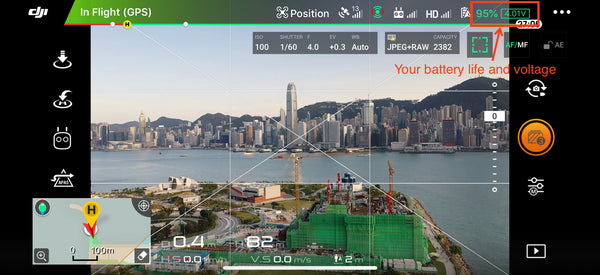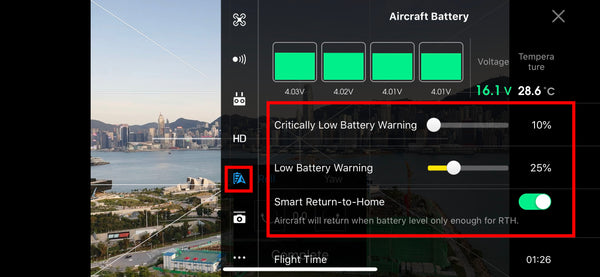After you have taken off into the sky, you can enjoy flying around like a bird. Enjoying what birds see (to some extent) on a daily basis.
But there are many risks that come with flying your drone. To prevent injuring people or mitigating damage to the environment or wildlife - here are some top tips so that you can enjoy your droning experience and come back with an undamaged drone!
1. Battery life

First and foremost - always look after your battery life. The default warning for low battery rings when the battery is at 30% of its capacity. This can be adjusted in the settings but it’s not recommended until you have a strong sense of how far your drone can return from based on a certain amount of battery life. Keep it at 30% until you have had sufficient flights under your belt and feel confident to adjust the warning threshold.
What happens if you don’t fly back and the battery life keeps dropping? Well, for DJI drones, there is a trigger mechanism which calculates its distance to the home point and decides at which percentage it has no choice but to “land now”. When this prompt is triggered, you still have control of your drone. You can keep flying until the battery life is flat at 0%. So a top tip for if you end up in such a situation is to gain enough altitude for the drone to descend during the “land now” mode. This will buy time for you to fly your drone back.

2. Battery voltage (especially in cold conditions)
When flying in cold weather conditions (near 0 degrees celcius), you need to look after the battery voltage as much as the battery life. Your drone requires a certain voltage from the batteries to keep alive. Generally speaking, you need to take note of the following figures:
- 3.3V - Prepare to land your drone
- 3.0V - Your drone is likely to lose power and free-fall
By default, your voltage display should be off. On a DJI system, you can enable the voltage display by following the below steps:
Select settings -> Aircraft Battery -> Advanced settings -> Show Voltage on Mainscreen

The details of flying in cold conditions will be covered separately.
3. Watch out for ATTI mode
In our first blog post - we mentioned to always acquire GPS mode before flying outdoors. However, there are conditions which may affect the number of GPS your drone can receive during flight. This is particularly true if you are flying low in a densely surrounded environment. Surrounding tall buildings can block GPS signals even when you are in-flight.
So here’s a top tip: Avoid signal block from flying near tall buildings (or large walls). Always try to have an idea spatially how the GPS signal is transmitted to your drone. Signals can be intercepted by solid objects such as walls or buildings. In the unfortunate event that you lose GPS mode in-flight, you can stop moving your drone. Try to navigate slowly around where your drone is or flying a bit higher in an attempt to recapture GPS mode. If it doesn’t work, you are recommended to fly back and safely land your drone - unless you are confident of flying in ATTI mode!
What are the issues with losing GPS mode? Your drone might start drifting - and you don’t want that to happen and end up crashing with a tree, or a building.
4. RC Signal Loss
Losing signal between your remote control and your drone is every pilot’s biggest fear. The signal transmission of the default Mavic Pro/Mavic 2 Pro series is transmitted in omni-directions to your surroundings. Understanding your equipment is the best way to avoid loss of signal.
Before we proceed - always remember to set your return-to-home height to be higher than any of your surrounding objects, be it trees, buildings, statues, or people.
RC signal loss usually happens in two circumstances:
- Range of the drone exceeding the transmission range
- Signal transmission from the remote control is blocked from the drone
The range of your drone varies in different environments. In urban areas the range tends to be less due to all the Wi-Fi being broadcasted in buildings. When you are flying, you can monitor the icons below to maintain the RC signal strength. If you see the number of bars are decreasing, then you should consider what are the reasons for this drop. Is it the range? Or is there something in the way? If something’s in the way, can you move yourself slightly to clear your transmission?
In the worst event, your drone will disconnect and you will see a grey screen. Don’t panic! Your drone to reach the RTH height which you have specified and will fly back to the designated home point. You should regain RC signal as the drone is flying back to you.
5. Wind speeds (and weather)
Firstly, you cannot see wind speeds in your DJI GO app because there’s no anemometer installed on your drone. So always check for the wind speed before your flight. The official wind speeds designed for various drones are listed below:
|
Drone |
Designed Wind Speed (m/s) |
|
Mavic Mini |
8 |
|
Mavic Air Mavic Pro Mavic Pro Platinum Phantom 4 Pro |
10 |
|
Mavic 2 Pro Mavic 2 Zoom |
10.5 |
As one would expect with any engineering - it comes with some factors of safety. So in reality it is generally safe if you exceed these limits by a little. I mean, winds can be gusty all of a sudden - right?
So, how does this all relate to when you are flying the drone?
First, you need to know the theoretical top speed of your drone. The theoretical top speeds of various drones are listed below:
|
Drone |
Top Speed (km/h) |
|
Mavic Mini |
46.8 |
|
Mavic Pro (sport mode) |
65 |
|
Mavic Air (sport mode) |
68 |
|
Mavic 2 Pro (sport mode) Mavic 2 Zoom (sport mode) |
72 |
Observe your top speed when you are flying out (or back). Is it faster or slower than the designed top speed? If you are flying out and your drone is exceeding the top speed - this means you will likely be facing winds against your drone when you return. Therefore, you will need to allow more time for it to return.
Oh and, if it looks like it’s going to start raining, or even worse - thunder, you need to fly back and land ASAP! Don’t risk it.
6. Obstacle Avoidance
As new drones are released by the year, more obstacle avoidance sensors are being installed into them. I remember my first drone (Mavic Pro) had sensors in two directions only - forwards and downwards. On the Mavic 2 however, you have omni-directional (or so they say) sensors which are supposed to protect your drone with a mighty aura.
Well - that’s not true, not exactly anyway. To prevent crashes, you need to understand how your equipment works.
There are sensors which work on your normal flights and there are sensors that only kick-in when you are on “Intelligent flight modes” or specific modes. Intelligent flight modes are things like Hyperlapse, Orbit, Rocket, etc… These will be covered separately.
On the Mavic 2, the side sensors only function during an intelligent flight mode or tripod mode, etc... As such, always be wary of what’s to the side of your drone when you fly manually.
7. Adjust gimbal (Roll/Yaw)
There’s always some inner OCD in some of us. I know I certainly do. And yet sometimes, the gimbal just likes to tilt a little on its own during flight for various reasons. To adjust this during flight, you can adjust your gimbal roll or yaw in an attempt to correct the tilt. You can do this by:
Menu -> Gimbal Settings -> Adjust Gimbal

8. Watch out for your home point
There are a few watch-its with home points especially if you are heavily reliant on this function.
- Home points can be inaccurate - check before you take off
- Home points can drift due to GPS inaccuracies
- Have you walked away from where you took off?
Personally, I’ve always preferred to return manually. Even if I lose signal, I prefer to take control of the drone on its way back to home point, and fly back manually.
9. Landing
Finally, landing the drone. After a full session of droning, you must be excited to collect all the footage from your drone. Don’t get too excited before you land it!
When you land, always look around your surroundings.
- Is there anyone who may walk past?
- Are there any birds flying above?
- Any other drones taking off or landing near you at the same time?
Be wary of your surroundings before you land. You do not want to crash into a drone nearby, or land and injure a passerby. Let any nearby drone take off or land safely before you proceed. Let the passerby pass and make sure he knows you are aware of his presence before you land. If you are on critically low battery, you could always ask everyone around you nicely to be aware of a landing drone so that they won’t pass by where you are landing. Be nice and respect those around you!
The BeyondVisuals Team


